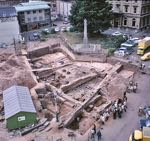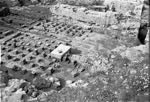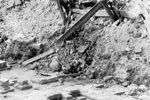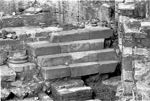
The Roman Bath House in Cathedral Yard
A photo essay
Page added 26th January 2015
Also see History of the Bath House
All photographs are by Alan H Mazonowicz unless otherwise labelled.
 Excavations from above July 1971
Excavations from above July 1971
This photo shows how close the Devon War Memorial is to the excavations.
Courtesy and © RAMM.
 Spectators view the site
Spectators view the site
The excavation attracted a healthy number of spectators.
© Alan Mazonowicz
 East end of the excavation
East end of the excavation
The end of the bath house closest to the West Front. © Aan Mazonowicz
 View towards the site office
View towards the site office
The archeologists had their own office to interpet the finds and provide a place for a quick coffee.
© Alan Mazonowicz
 Young archeologists
Young archeologists
Most photos of the excavation indicate
a sunny summer. The brown backs in this photo confirm the good weather.The young woman is sitting on the steps that led to the bath house–her body indicates how large each stone was for the steps. © Alan Mazonowicz
 Hypocaust under the floor
Hypocaust under the floor
The floor of the bath house rested on the short pedestals of the hypocaust, creating an under floor space for the hot gases to flow, and heat the floor.
© Alan Mazonowicz.
 Hypocaust under the floor
Hypocaust under the floor
A different view of the hypocaust. © Alan Mazonowicz
 Tunnel under a wall
Tunnel under a wall
This tunnel carried the hot gases from one section to another. Workmanship like this was lost after the Romans left, and their advanced technologies forgotten for a thousand years.
© Alan Mazonowicz
 Floor over the hypocaust
Floor over the hypocaust
After St Mary Major Church was demolished in 1972, the archeologists removed the church's floor to expose pre Saxon remains. After their careful removal , the upper Roman archeology was found. This is probably the floor of the bath house, beneath which, was the hypocaust. © Alan Mazonowicz
 Human remains
Human remains
The human remains in the centre of this photo were probably at the edge of the site. They are fairly jumbled, as they were from the later Christian burial ground surrounding the Cathedral.
© Alan Mazonowicz
 Human remains
Human remains
By 1637 the level of the burial yard around the Cathedral was up to the windows.
St Batholomew Yard was opened and Cathedral Green lowered. The remains shown in this photo indicate many years of burials. © Alan Mazonowicz
 Pre Saxon remains
Pre Saxon remains
The skeleton behind the archeologist was under the Saxon church of St Mary Major. It was thought to be one of the earliest Christian burials in the city.
© Alan Mazonowicz
 Pre Saxon remains
Pre Saxon remains
A closer view of the skeleton in the previous photo. © Alan Mazonowicz
 Detail of the excavation
Detail of the excavation
Planks are laid across parts of the site to ensure safe access for the workers.
© Alan Mazonowicz
 Detail of the excavation
Detail of the excavation
Many buckets were used during the excavation. © Alan Mazonowicz
 Detail of the excavation
Detail of the excavation
Wheelbarrows are another useful tool for archeologists.
© Alan Mazonowicz
 View to the south
View to the south
A view across the site towards South Street. © Alan Mazonowicz
 Roman steps
Roman steps
These steps led down to the bath house. Notice the base of a carved column to the left.
© Alan Mazonowicz
 Bricks and tiles
Bricks and tiles
Many Roman bricks and tiles were used in the construction of the hypocaust. © Alan Mazonowicz
 View towards the Three Gables
View towards the Three Gables
St Mary Major Church was built onto the side of the Three Gables. This photo shows the position of the excavation relative to these three houses.
© Alan Mazonowicz
 View to the north-east
View to the north-east
The steps previously mentioned are centre right in this view across Cathedral Green. © Alan Mazonowicz
 Roman arch
Roman arch
A Roman arch constructed from bricks allowed the hot gases to pass through.
© Alan Mazonowicz
 View across to the West Front
View across to the West Front
It is easy to assume that the bath house is right in front of the West Front, from this photo. However, the angle of the towers indicate that the remains are well to the right of the steps down from Broadgate. © Michael T J Wride.
 Covering over the site
Covering over the site
Once the archeologists had thoroughly investigated the site it was decided to cover it over with sand to preserve it. The Cathedral's plans to expose the bath house and build an interpretation centre will be easier because of this foresight. Courtesy Express and Echo.
│ Top of Page │